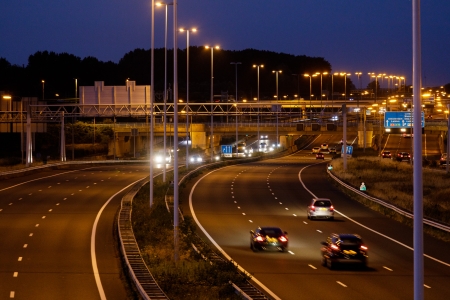Public lighting
Meta-analysis on the basis of studies from different countries has shown that the number of accidents in darkness substantially decreases after installing public lighting [2] [4]. On Dutch roads, the installation of public lighting leads to a 50% reduction in the number of nighttime injury crashes [7]. The positive effects of lighting are usually abated by the human tendency to behave less safely once the environment appears to be safer. This is called ‘behavioural adaptation’ [6].Yet, the net effect is (very) positive.
|
Road type/road environment |
Fatal crashes |
Injury crashes |
Crashes resulting in material damage |
|
All road types |
-60% |
-23% |
-16% |
|
Motorways |
not determined |
-13% |
not determined |
|
Rural areas |
-87% |
-26% |
-27% |
|
Urban areas |
-43% |
-29% |
-14% |
|
Intersections in rural areas |
not determined |
-22% |
-30% |
Table 1. Effect of public lighting on nighttime accidents on previously unlit roads[i] [2].
Table 1 shows that the installation of public lighting along roads affects the number of fatal crashes more than the number of injury crashes or crashes resulting in material damage only. Moreover, in rural areas the effect of lighting is stronger than in urban areas, especially where fatal crashes are concerned. The installation of public lighting also affects the pedestrian accident risk more than the motorists’ risk. [2] [8]. Research in the Netherlands shows that public lighting affects the safety of vulnerable road users (pedestrians, cyclists, moped riders) more than the safety of motorists[7].
Research into increasing the existing level of illuminance shows that the effect depends on the extent of the increase and the level of illuminance before the increase [2] [9]. See Table 2.
|
Extent of the increase in illuminance level |
Fatal crashes |
Injury crashes |
Crashes resulting in material damage |
|
Up to twofold |
undetermined |
-8% |
-1% |
|
Twofold to fivefold |
undetermined |
-13% |
-9% |
|
More than fivefold |
-50% |
-32% |
-47% |
Table 2. The effect of increasing the illuminance level on the number of accidents, as reported in international studies [2]
This does not mean that switching off the lighting or lowering the illuminance level always has a negative effect on road safety. The effect appears to depend on the extent of the reduction in the illuminance level and the circumstances on the road, such as traffic flow and the complexity of the road design (also see the question What is the road safety effect of (partially) switching off public lighting on motorways?).
Vehicle lighting
We are not aware of any research into the road safety effect of motor vehicle lighting in darkness. Considering the function of vehicle lighting, a positive effect seems likely (also see the question Why is (adequate) lighting important for road safety?). That the use of vehicle lights is not under discussion, could explain the non-existence of research into the effect. We do know, however, that motor vehicle lighting has a positive effect on road safety (also see the question What is the road safety effect of daytime running lights?). Cycling in the dark is safer when using adequate bicycle lights. Reliable figures about the extent of the road safety effect of adequate bicycle lights are missing however (also see the question How dangerous is cycling in the dark without adequate bicycle lights?).
[i] For a number of categories (injury crashes on all roads and on roads in rural areas) the meta-analysis by Elvik et al. contained sufficient results to correct them for publication bias. Publication bias refers to the bias that arises when especially those research results are published that are significant or positive, which means that negative or unclear results are underreported. Since not all categories have been corrected for this bias, only the uncorrected results are presented in this factsheet, so that the results may be compared.
